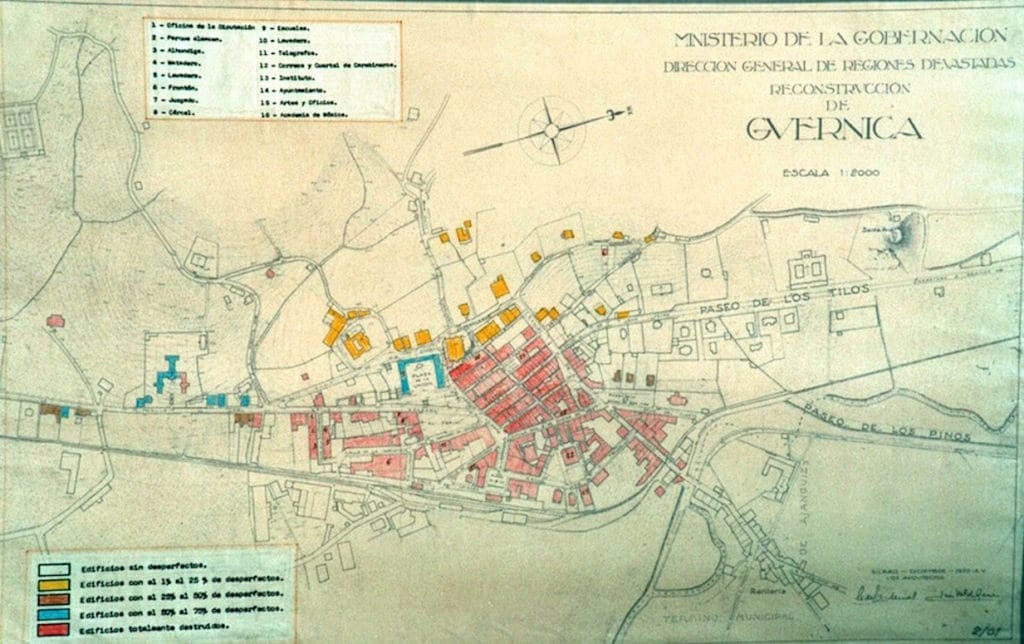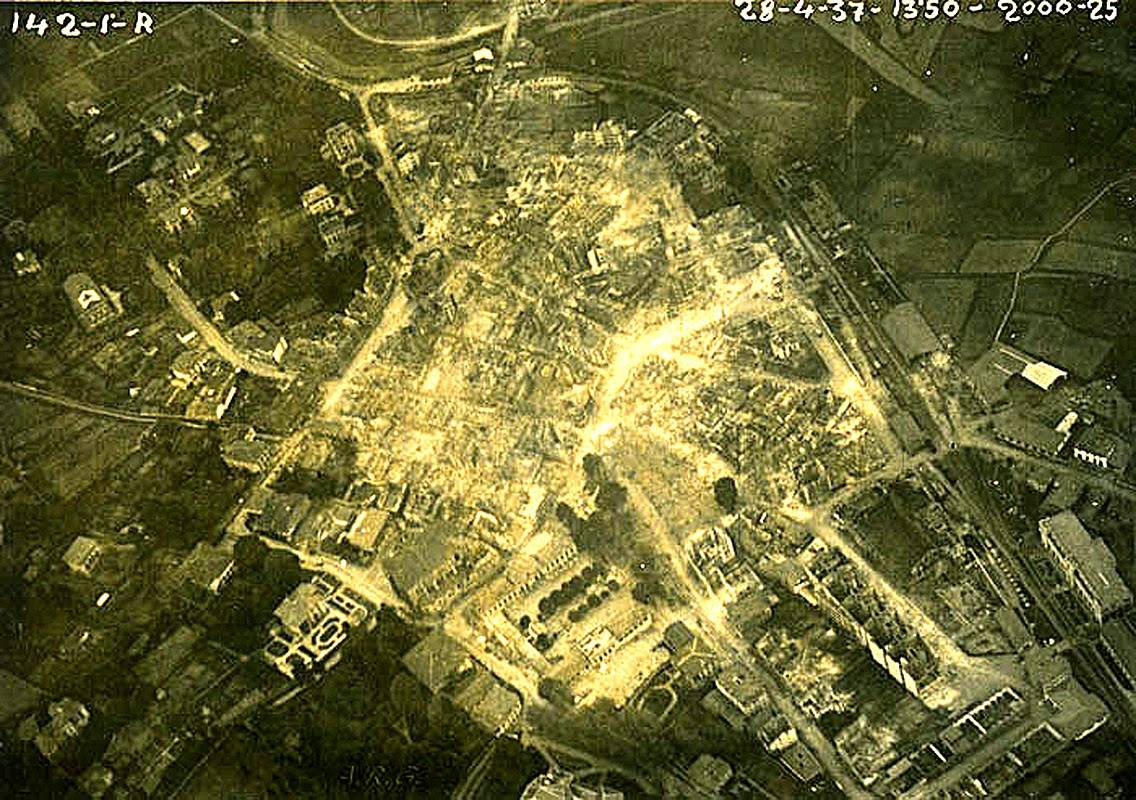On March 20, we came across the ignominious article published on the The Aviation Geek Club website, where Italian Dario Leone, the site’s founder and editor, dares to write about the Bombing of Gernika. Upon reading it, we thought it best to wait a month, and address our reply to him on the day on which we commemorate the bloodbath the Francoist insurgents and their allies, the totalitarian Italians and Germans, brought upon a defenseless city.
We have no doubt that Mr. Leone knows a lot about airplanes, and we’re sure that just by looking at one he can rattle off all its features and data without making a mistake. But we’re also sure that he knows a lot less about the Bombing of Gernika than he thinks, and then spews out that vile article researched only by reading texts written by those who never saw what happened as a bad thing.
Honestly, we’re not even sure where to start, so we’ll just take it from the top, to cover the bunk he’s spouting point by point.
First we have his claim that the reports were “wildly exaggerated”. We imagine he’s referring to the reports of the survivors, those of the journalists who saw the bombing and the consequences of that rebel attack, and those stating the number of victims which were published by the Basque Government.
So, the “truth is exaggerated”. It’s a “shame” that Steer, Monks, and other international journalists who witnessed the consequences of the bombing and were able to publish what they saw. Without their meddling, we might still have to be reading that it was the “Reds and Separatists” who blew up and burned Gernika.
To think that a government at war would “inflate” the damage caused by the enemy is brushing on the ridiculous. The last thing a government would want is to demoralize the population making them believe that the enemy has the ability to do all the damage it wants. The Basque Government never gave exaggerated figures of the casualties caused by the rebel bombings (as a side note, enough is enough whitewashing the insurgents by calling them by the name they gave themselves to hide the fact that they were delinquents). The earlier bombings, such as the on in Durango, which happened on March 31, proves it. The difference between Durango and Gernika is that in the former, the population was under the control of the legitimate government long enough to be able to rescue the victims and count them one by one; in the latter, the insurgents took over soon after, and were able to hide some of the consequences of their war crime.
And to claim that the 32 tons of highly explosive bombs and incendiary devices had only one goal, to destroy Renteria Bridge, would be a joke if we weren’t talking about something so serious. It’s like hearing a military historian who’s close to the insurrectionists and their dictatorial régime say “they just happened to be carrying incendiary bombs,” as if it had been pure happenstance.


Renteria Bridge was/is a concrete structure of just a few meters spanning a small river which later becomes the Gernika Estuary.
The goal of the bombing was to raze the town while also causing as much harm as possible to the civilian population. This is shown by the type and number of bombs; the date chosen: market day; the machine gun strafing by the fighters on the civilian population that was trying to feel the inferno of explosions and fire that the German and Italian planes had wrought. To say anything else is to either be ignorant or lying.
The excuse that the smoke “blocked” the view of the target, the bridge, is beyond risible. It’s an excuse born of the international repercussions the bombing had thanks to the international journalists who had been in Bilbao and were able to write freely, without censoring, and wrote what they saw. Elsewhere, the censors blocked such a terrible truth from getting out.
He also claims that “one end of the town was totally wrecked”, and leaves it at that. If anyone would like a bit more information, all that’s needed is to look at the aerial photos taken by an Italian plane, or the map of damage the insurgents themselves drew up for the reconstruction of the town.


Then the article makes a “mistake” that almost seems premeditated. The Francoists did not enter Gernika three days later. They entered on April 28, two days later, meaning the idea that the Basques had enough time to clear the streets to allow Basque troops to retreat is beyond absurd. There was only one day to do the absolute essentials: evacuate the injured and recover the bodies. Plus, it needs to be said, most Basque troops that were in retreat were walking, not in vehicles.
He also “explains” that the destruction of the same logic used by those who would then go on to destroy Europe: “since bombing a specific target like a rail line or a bridge is hard, let’s destroy everything”. Their goal was not a bridge: this is proven by the types of bombs they carried. We point to the obvious: they were out to raze the city and cause as many civilian casualties as possible.
And it is at this point that we start with the orgy of Franco-style reasons.
He says the city was not defenseless because there were two battalions of the Basque Army there. As if that were significant. It’s the logic of warmongers: everything’s fair game.
Gernika was a defenseless city because it did not have an anti-aircraft battery, nor were any Republican planes able to provide any air cover. To say otherwise is to think like a war criminal.
So yes, it was a terrorist attack, like everything the insurgents and their Italian and German allies did. In Gernika, there were many more civilian deaths than military. There were schools, hospitals, a market, convents: without a doubt, a town full of civilians, defenseless.
He also casts doubt on the number of deaths published by the Basque Government. And in doing so, he also casts doubt on the eyewitness testimony of the Daily Express correspondent Noel Monks, who describes what he saw on the morning of the 27th as follows:
“I was back in the blackened town at dawn. The flames had died, but the ruins were smoldering. I saw more than eight hundred bodies. An estimated 300 more I couldn’t see, because they weren’t bodies: they were just hands, legs, arms, heads, bits of flesh. Many bodies had bullet wounds: airplane machine-gun bullets”.
“There’s something about this war that gives me the creeps. Could you ever meet a finer lot of people in the world than these Basques — home-loving, industrious, religious? And they’re being wiped out with the blessing of the Pope. It makes me afraid for humanity.”
The Francoists were lying delinquents, as they proved time and again. The Basque Government wasn’t. Theirs are the only numbers that should be taken into account.
Because saying that there were only 7,000 people in Gernika at the time is yet another bald-faced untruth. There were many more people: patients in the hospitals, retreating troops, local farmers in the market: a number much larger than that of the official census. And of course, forget about death certificates: they even went so far as to alter dates of death so they wouldn’t coincide with the days just after the terrorist attack.
There seems to be a permanent desire to downplay the bombing. Some seem to want to absolve the guilty; others, we’re not sure. Maybe they just want their fifteen minutes. Who knows.
If anyone would like to know more about what the Bombing of Gernika was and what it meant, you must read and listen to Xabier de Irujo. It’s the most scientific contribution to what this bombing was.
By the way, the Nazis didn’t need Gernika to stoke the fire of their reputation as cruel assassins. They needed Gernika, like other Basque, and Spanish, cities, for target practice, to prepare for what they were planning to unleash on Europe soon after. To think that there was collusion between British journalists at conservative newspapers and the Basque Government on the night of April 26 to turn Gernika into propaganda is halfway between delirium and moral wretchedness.
Briton Chamberlain and Frenchman Deladier did not fold before Hitler after his invasion of Czechoslovakia because they were afraid of new “Gernikas”; they did so because they believe that with that, the monster would be satisfied and thus leave them alone. They did exactly what the Allies did at the end of the Second World War in Europe: since Franco was a problem that didn’t affect them, why make an effort? Those who had fought for them against fascism were no longer useful and thus left to their fate.
We have a recommendation for Dario Leone: you may know a lot about planes, but you know nothing about the Bombing of Gernika. You mustn’t forget that it’s better to avoid talking about things you don’t understand. By the way, you seem to omit that Italian planes also participated in that bombing. Or that the Bombing of Durango was by Italian planes exclusively. Perhaps you’ll also need to be reminded that the fascist Italian air force, just before Gernika, used chemical warfare in Abyssinia.
And for us, all that is left is to remember those who suffered in the bombing, and, once again, another year on, for all those who were murdered and who are still buried in ditches, to ask for
Truth, Justice, and Reparations
That’s something you’ll never find in the article at The Aviation Geek Club.
Those who’d like to know more about the Bombing of Gernika can take a look at this article, where we’ve complied some of the entries we’ve written about this tragedy.
The Aviation Geek Club – 21/3/2020 -Italia
Here’s why the bombing of Guernica was Hitler’s greatest victory in the Spanish Civil War
When the Spanish Civil War broke out in 1936, the Luftwaffe was a new air force, having been established in secret and only officially formed in 1935. But it was rapidly expanding, and already in a position to help its ideological allies, Franco’s Nationalists. The Luftwaffe’s expeditionary force —the Legion Condor — launched the world’s first major airlift to bring Franco’s troops to Spain.
(Follow) (Automatic translation)
Last Updated on Dec 20, 2020 by About Basque Country































